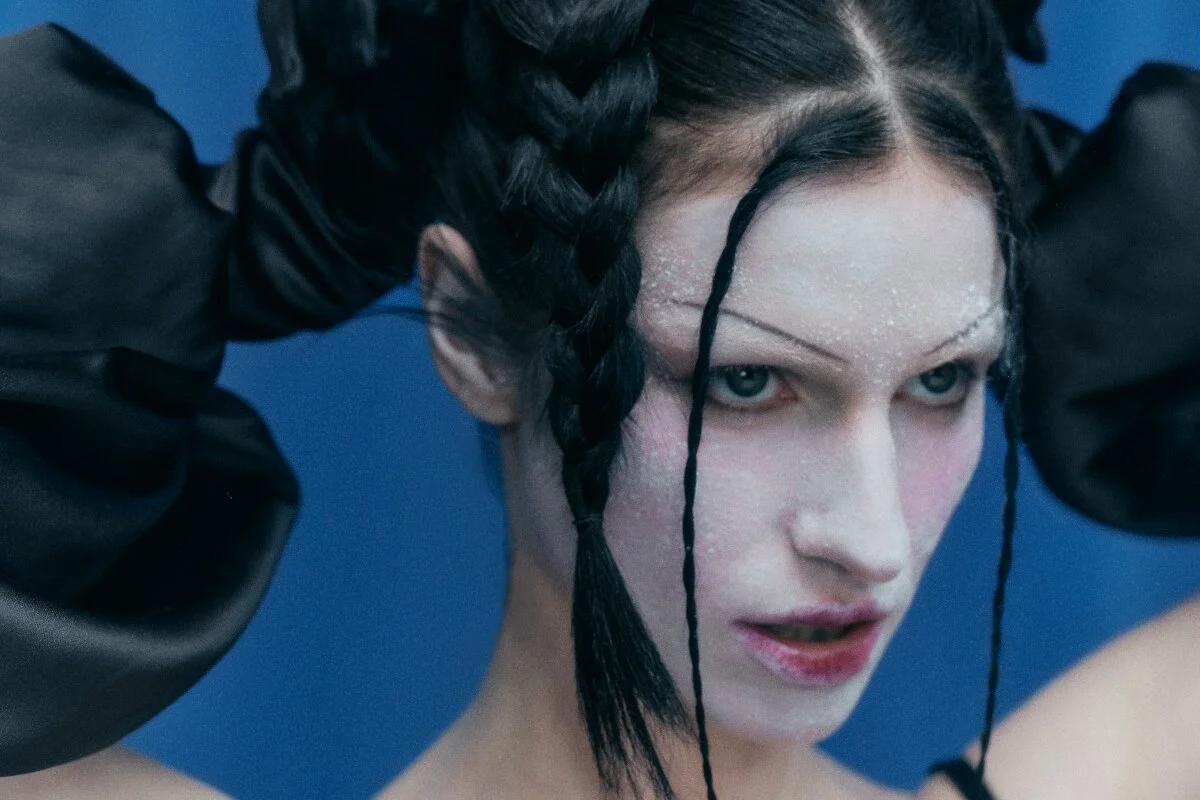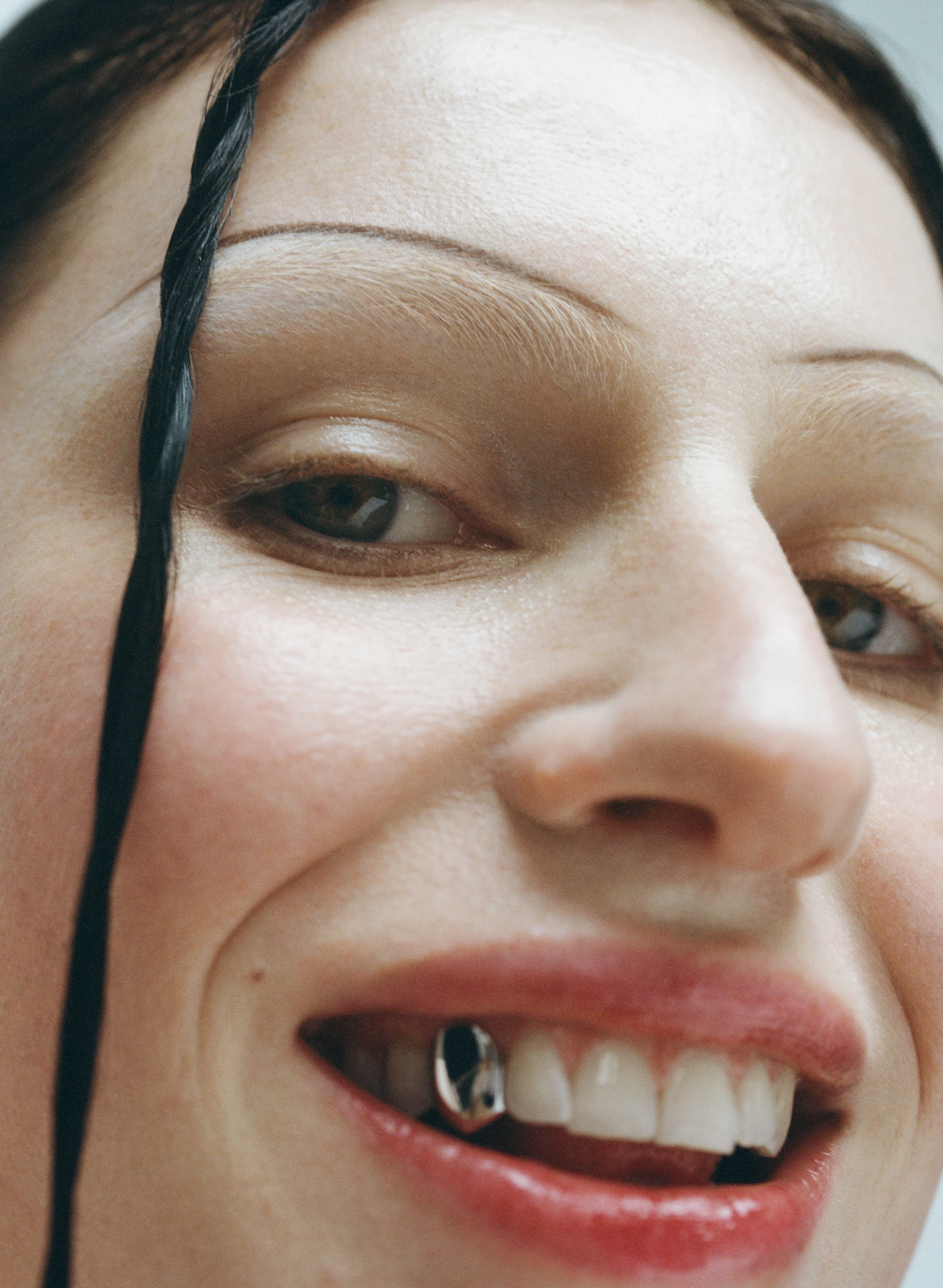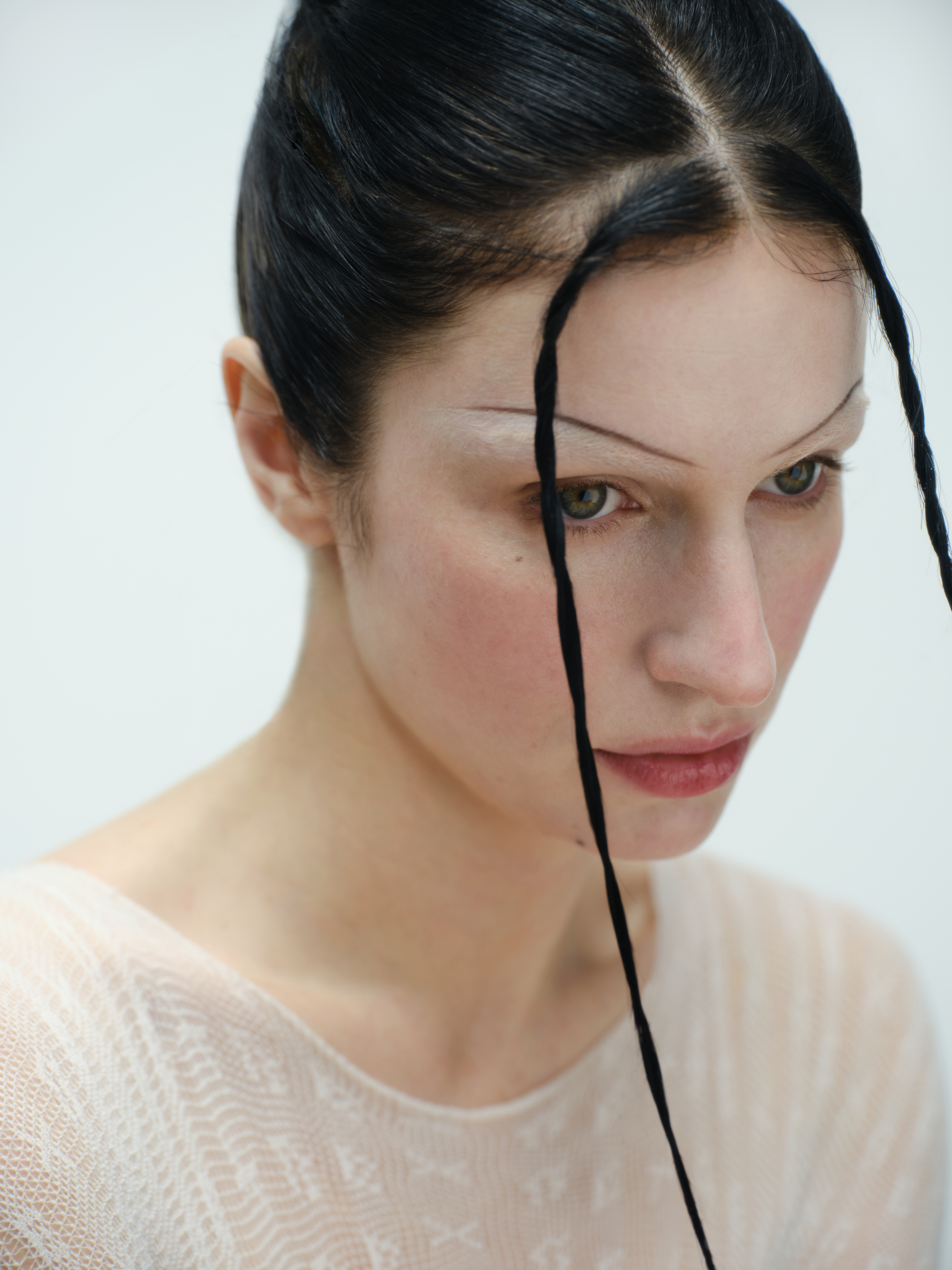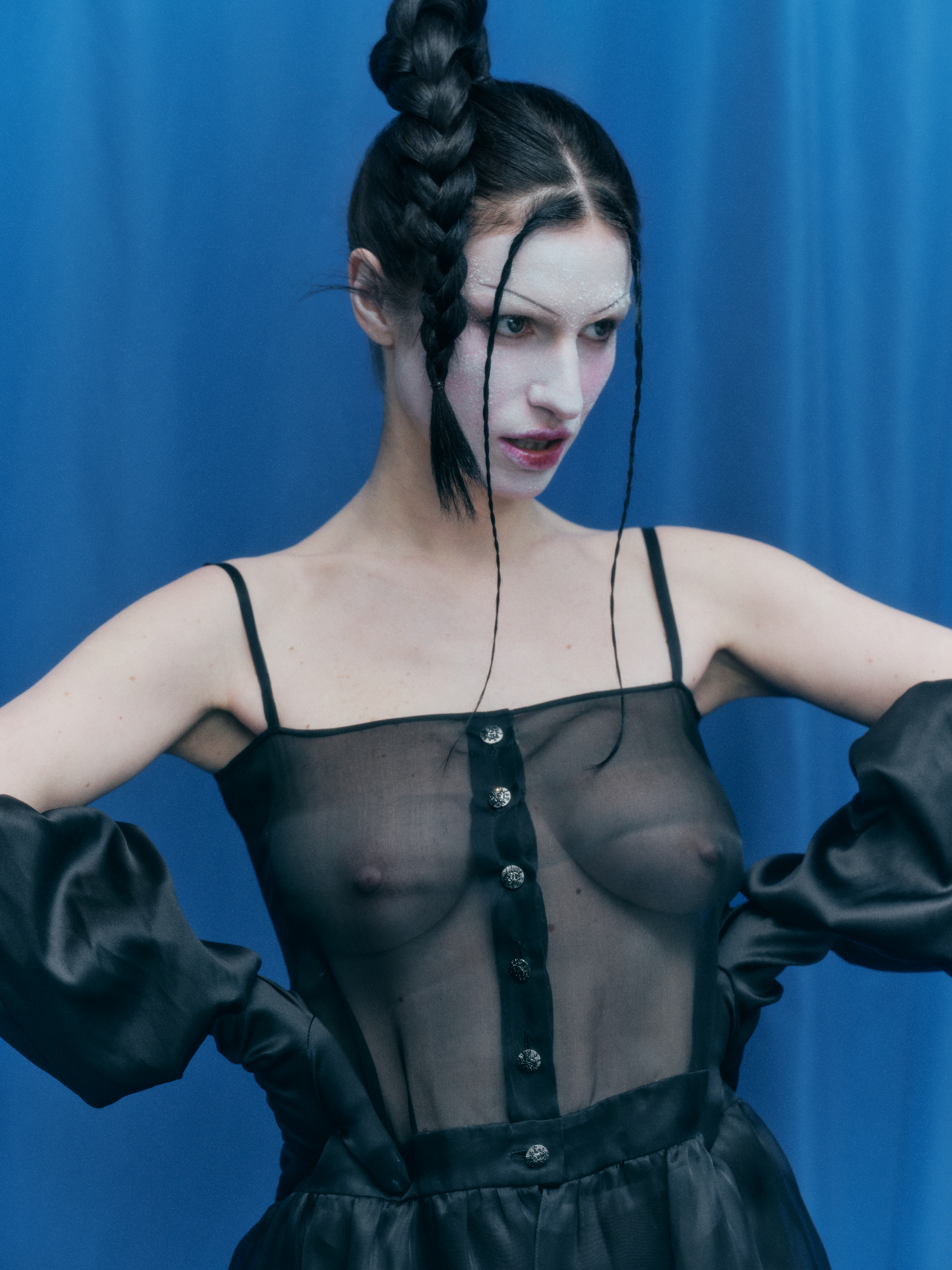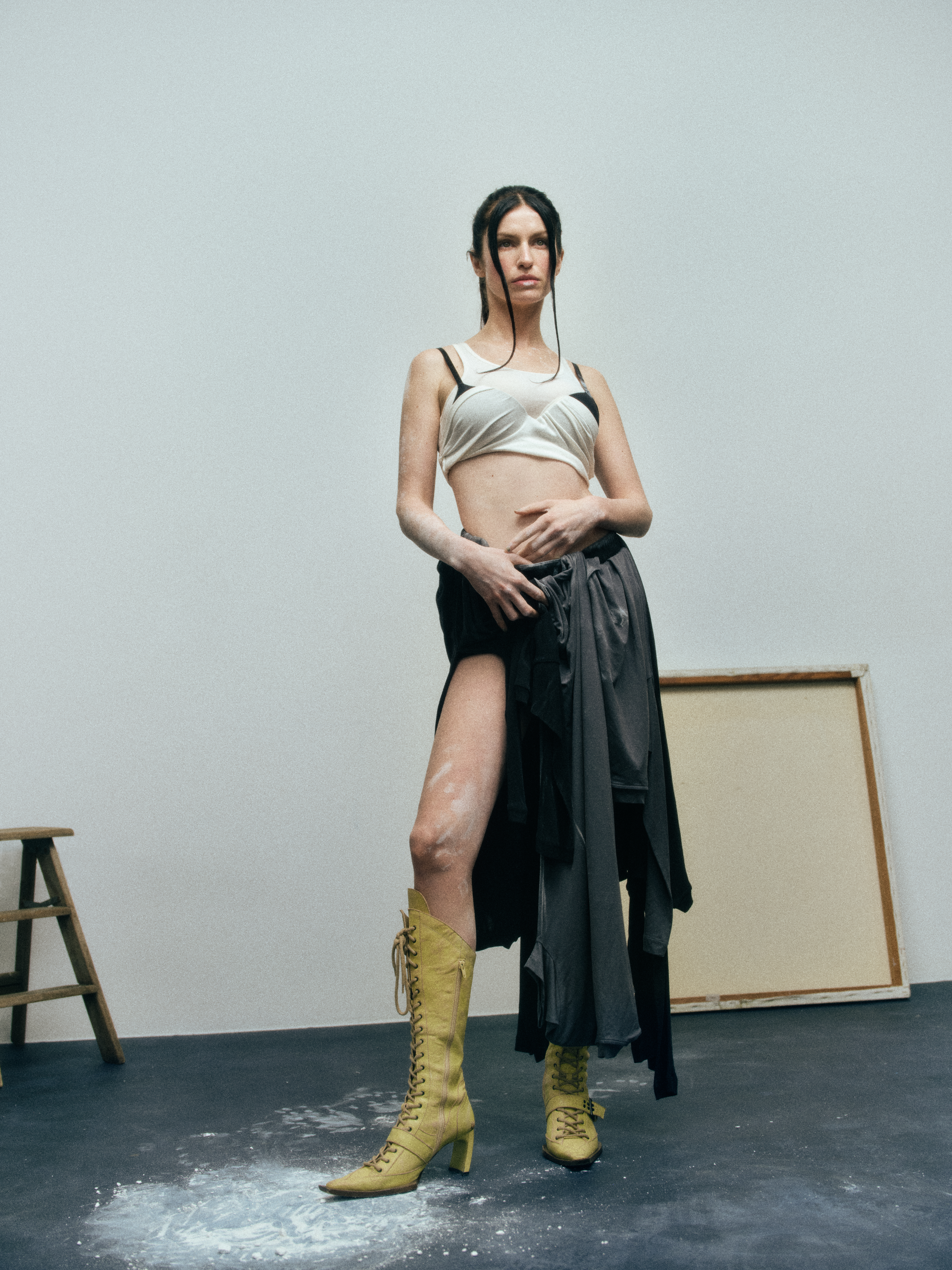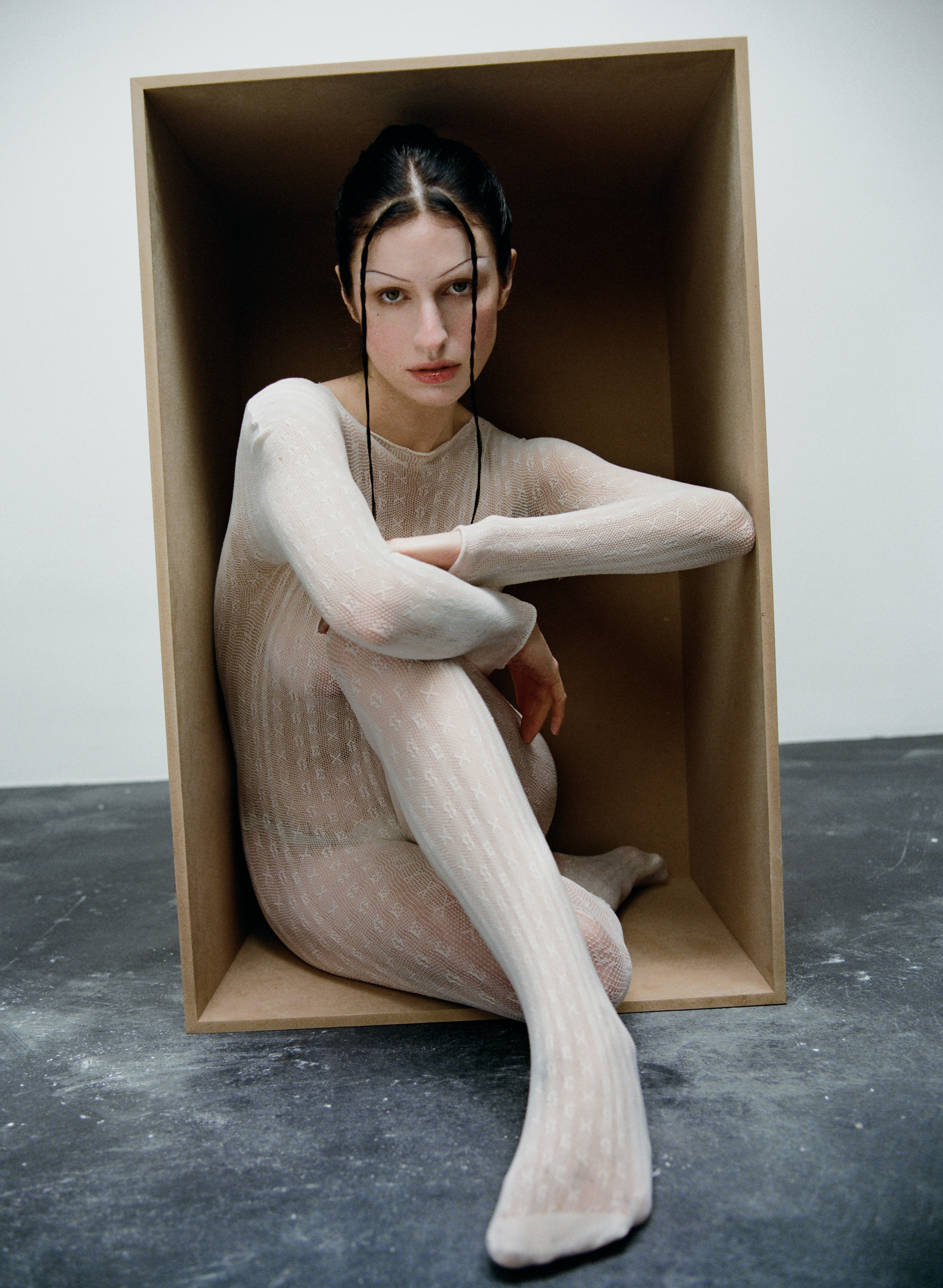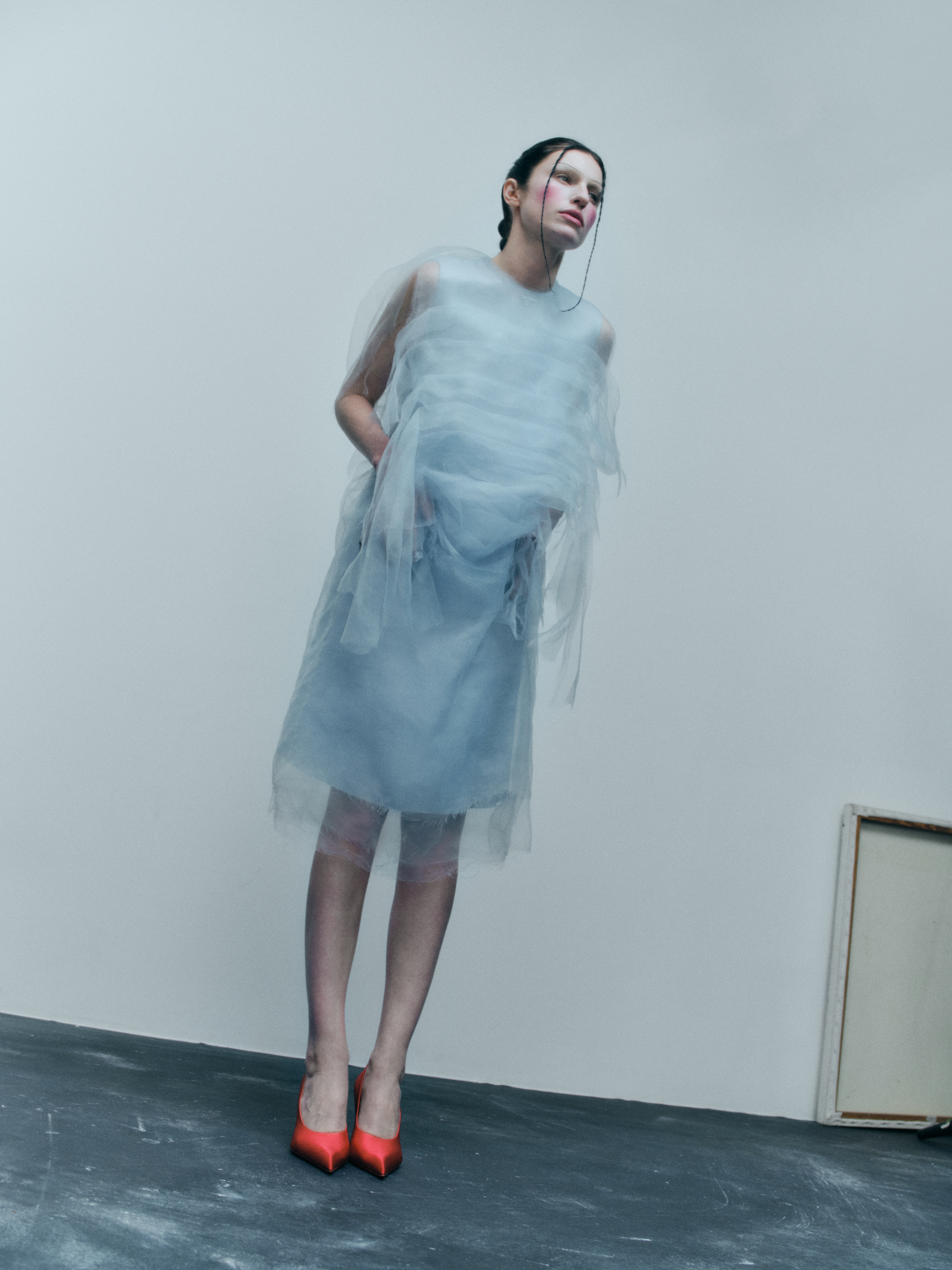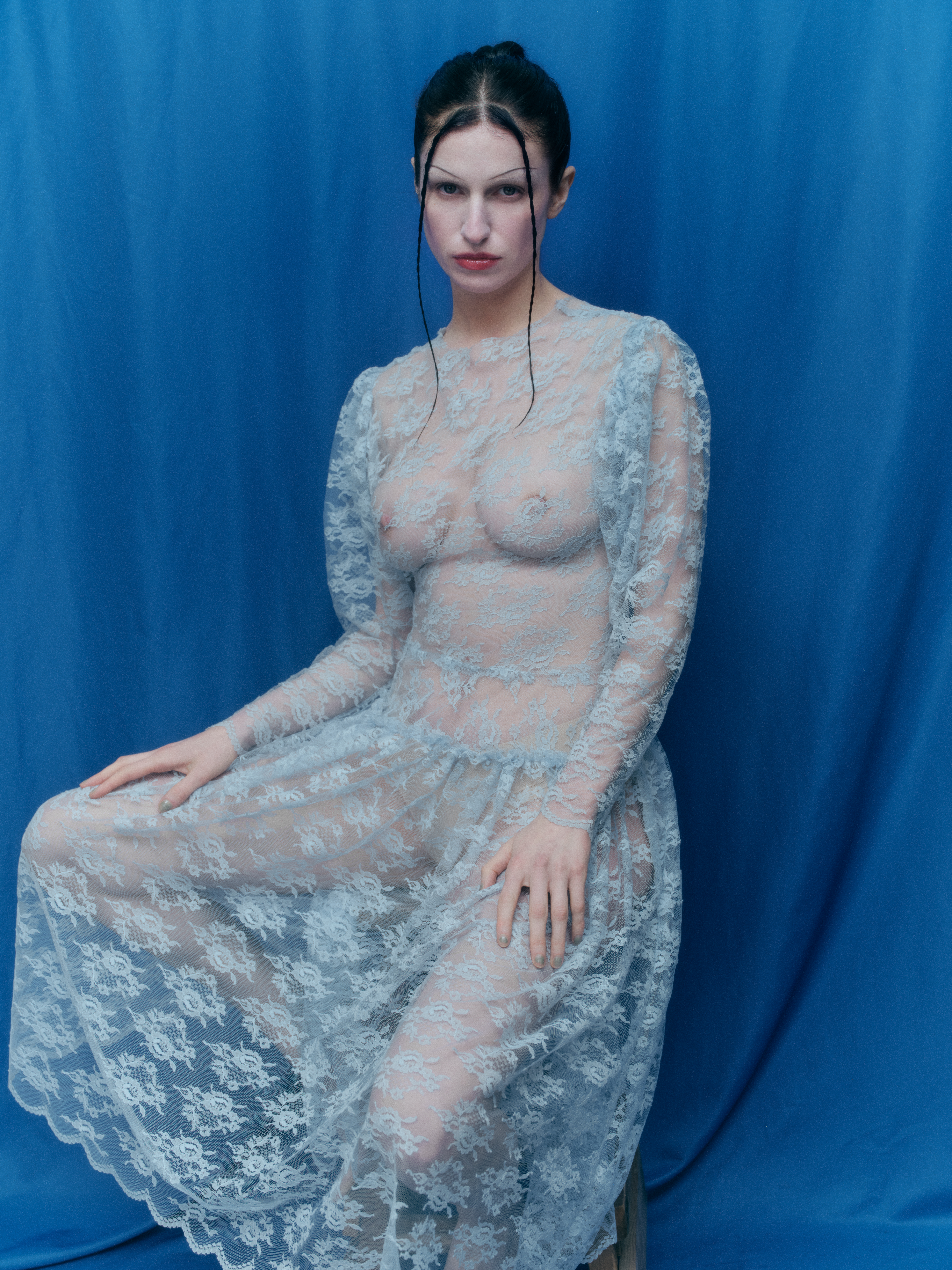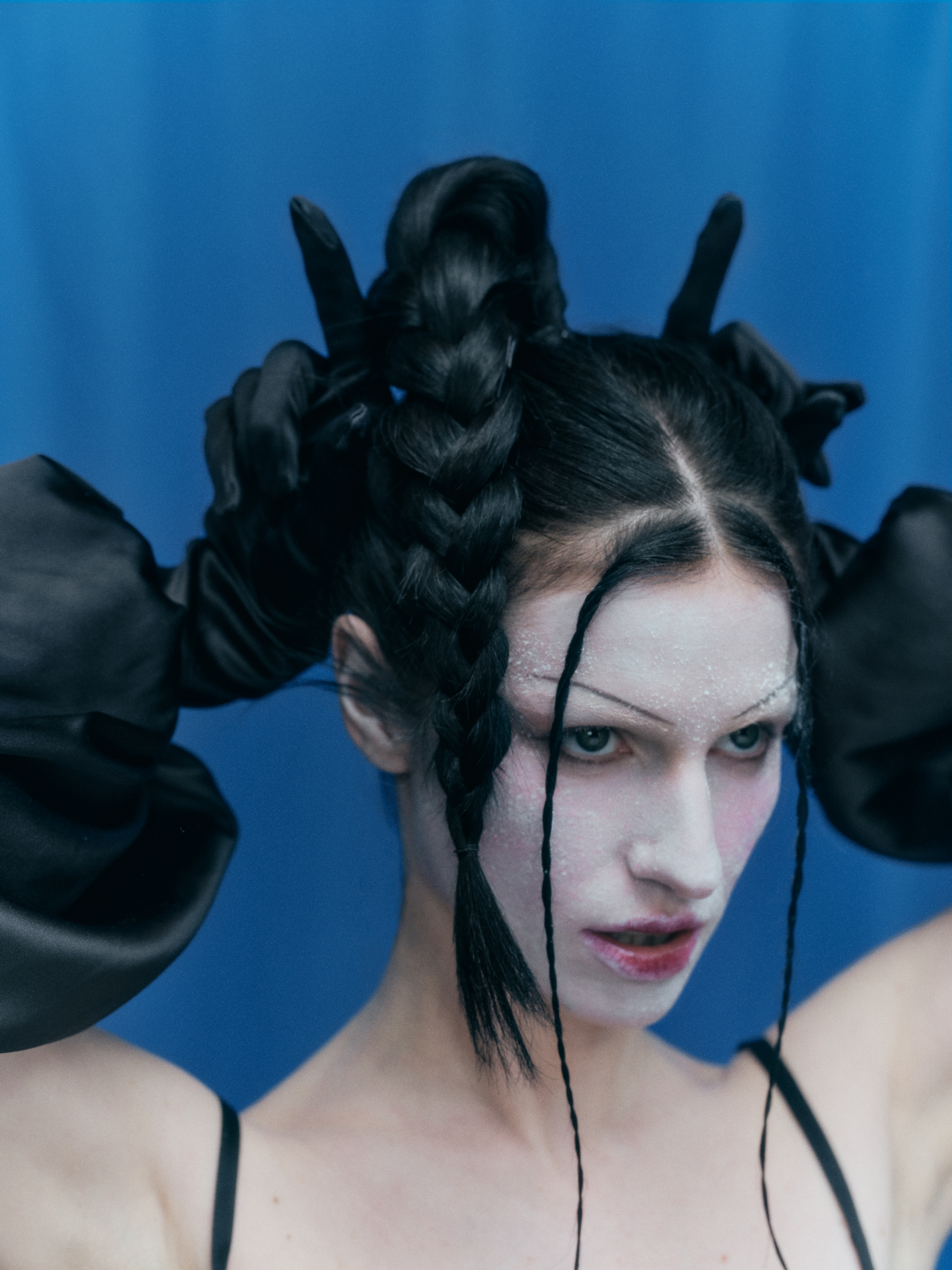Tali Lennox interview with Lampoon, the Boiling issue:I like to capture the void in between where one has a physical or environmental eruption. Photography Olivia Malone, styling Carolina Orrico
The Ballad of Linda Leven, Tremors
Tali Lennox’s new exhibition Tremors opens in Nicodim Gallery at a moment when many people can connect with the theme. Rather than specifying what concerns the beholder should have amid the world’s chaos, the series offers a blank space for catharsis to find solace. Lennox alternates between extreme utopia and dystopia, exploring both the foreshock and the aftershock of global issues. Erupting volcanoes, hollowed out figures and gloomy glowing realms fill her canvases, supplemented with metaphoric oysters and shells. This ambiguous extremity creates room for climactic release and surrender to something greater than us. Lennox herself finds pleasure in this, calling it a sense of wonderment.
Since The Ballad of Linda Leven, her first solo show in New York in 2019, Lennox has been moving closer to her artistic pivot. Her oil paintings delve into dark spirituality, emphasizing its eroticism and its potential to impart contemplations about life and death. Revitalized muses emerge from bygone eras and fantasy lands, using a wealth of symbolic elements. Recurring themes include the destructive and creative power of nature and the subordinate position of humanity. Lennox refrains from preconceived ideas. Her work consists of notions and reflections, seen through the eyes of the woman she has become after 31 springs.
Tremors, Tali Lennox
ANNA ROOS VAN WIJNGAARDEN
Tremors – submit to chaos and explore the power of natural disorder with a sense of pleasure. A tricky approach, considering the real natural dangers not far ahead of us.
TALI LENNOX
I didn’t plan to make the show environmental – it arose for me on contemplation. I prefer to work on instincts and trust that my psyche will unfold a layered story. I reflected on a joint universal unease. There is a sensation that you can’t not notice and it means something. Tremors are approaching almost like before a flood. When you think about the larger picture, the cycles of the earth thousands of years back in time, there have been many falls of ancient empires and civilizations. Life cycles, comic crashing, natural disasters, who knows what that could feel like? There is a serenity in realizing humans don’t have dominance over the tides of the universe. It makes one feel like a grain of sand within a grain of sand. I capture the void in between where one has a physical or environmental eruption. That’s why a lot of the paintings have volcanoes or open anatomy: wherever there’s a cracking, that’s when change and growth happens. It’s painful, but transformation is based on morphosis, and history has always seen a cyclical notion of a return to nature.
Tali Lennox, Uri Fruchtman –The Book of Miracles, Das Wunderzeichenbuch, Just Stop Oil in England
ANNA ROOS VAN WIJNGAARDEN
The series takes the lead from Das Wunderzeichenbuch, a German book filled with Renaissance paintings depicting biblical and medieval scenes.
TALI LENNOX
I’d seen the original copy of The Book of Miracles in a show in New York. Nobody knows who created it and the mystery of it blew my mind. It mixes folklore, religion, and natural disaster; it’s surreal. One page shows an open landscape with bits of red flesh raining from the sky. There is a tremor of past whispers, an oncoming tsunami of change. In our time, we’re starting to feel more on this edge. I weave in ancient history and past storytelling with a sense of urgency and contemporary notions. I can’t say I’m an environmental activist, but it is an artist’s job to create images that help describe a psyche and this topic of tremor is a universal psychological notion.
My dad (Uri Fruchtmann, ed.) does quite a lot of work for Just Stop Oil in England, which I know have controversial methods of protest. We went on a father daughter trip to Bruges in the summer and I noticed how aware he is of the oncoming severity of natural disaster and the social unrest that comes with global warming. He was opening my eyes to it, because as an artist, I often remove myself a bit from the world. It felt wild thinking about these oncoming futures in a medieval Belgian city with its ancient mystery.
Tali Lennox: a sense of wonderment, death, disruption and beauty
ANNA ROOS VAN WIJNGAARDEN
Your artistic identity seems to ponder between apocalypse and utopia.
TALI LENNOX
I add an element of fantasy or folklore to my paintings, like in old Germanic fairy tales where the writer is telling a story that is quite sinister. There’s always death, disruption and beauty involved. It has this duality, but with an innocence. My work doesn’t shy away from the morbid, but underneath is always the notion to maintain a sense of wonderment. It is centered around how often in life two opposites can be held close together, like birth and death, the breaking through an eruption or how something alluring can quickly turn into a nightmare. I’m not someone who swings in one direction and stays there. I go to the world of wonderment and innocence and then back to despair because that is what most of life is: both. I’m drawn to the most intense openings one can have emotionally. I tap into those psychological, experiential spaces when allowing ideas to channel through.
Symbolism is like a treasure hunt – Tremors by Tali Lennox
ANNA ROOS VAN WIJNGAARDEN
Your paintings speak to feminine desire – even fetish, evoked by symbolic natural objects with an erotic sentiment.
TALI LENNOX
I uncover points of secrecy, shame, and perversion. I’m thrilled by the idea of someone looking at one of my works and feeling uncomfortable. Which doesn’t make me a fetishist. Most human beings have – still – so much shame and unease towards sexuality or fetish. Protecting those secret places within oneself is an experience we can all relate to. I wish my paintings uplift a psychological veil and make people question their own reactions.
Symbolism is like a treasure hunt. You gather objects, ask yourself what they represent to different people and how you can use them to make your own kind of laws. One painting in Tremors has a human heart in the center with an oyster growing out of it. Around the sides, you see metal objects based on real pieces created by Betony Vernon, who’s a sexual anthropologist. She is a silversmith and made a boudoir box with tools for sexual pleasure – no plastic and no electricity. These pure silver objects of desire also give humans access and an opening. They allow us to enter a space of transcendence.
Tremors is also about a sense of return and going back to before you even had memories. There are many oysters, crustaceans, and caves in the paintings. Some women’s faces are oysters, representing a female anatomy and human return. This idea comes from Aphrodite, who was buffed out of shell from the ocean. We all come from a woman’s womb, which reflects in a larger sense water and the ocean. The same archaic wisdom resides in crustaceans and barnacles stuck on a rock – they stay stoic when waves crash onto them. I noticed this when I visited several caves over the summer, and it made me feel a deep sense of return.
About death – Tali Lennox and the acceptance of death
ANNA ROOS VAN WIJNGAARDEN
You’re not afraid to touch upon dark topics, such as death – society is giving death so little attention.
TALI LENNOX
We still try to theorize death, hide from it, or run away from it. It would be healthy if people would talk more about death as a notion and perhaps also lean into the beauty of soul transcendence. We don’t remember what happened before we were born, so why do we find it so hard to grasp that we could have nothing afterwards?
This lack of control is also frightening. Once, a taxi driver told me that served in the military for fifteen years and saw a lot of deaths. I asked him if he had PTSD and he said no, because he grew up in a family that ran a funeral service at home. He was so used to it, he even put makeup on his mother after she died. There is great beauty in such acceptance. I’ve faced the death of people I loved in an upfront way. It may sound whimsical, but if you know that person well, you know what they would say to you if you needed them here. If you want to feel a connection to them, you can tune into that essence.
Magical realism, Frieda Kahlo and the dreamike aesthetic of Tali Lennox
ANNA ROOS VAN WIJNGAARDEN
Your art is often put in the box of magical realism.
TALI LENNOX
People say Frieda Kahlo was a magical realist. It can be dreamlike, but it’s also rooted in striving for an essence of truth. There is something honest and self-reflective about her work and the scenes she painted are not completely broken down and abstract. As an artist I take the time not to feel like you need to explode onto a culture. There is freedom in being able to paint whatever you like. I’ve learned with time to be humble, let the work come to me and not get attached. The belly of painting is a solitary private experience. The rest is extra, because once you release work, it’s not yours anymore.
We all have our inner psychology, and we look at an object or a symbol and relate to it in different ways. There is a beauty in placing an image in front of somebody and then allowing them to travel with what they see. It’s storytelling, but it’s also a mystery. Each artist has its own realm. As a painter, it’s simple. I see it in my mind’s eye – a landscape with images and lots of fun and dark parts. As long as I keep my eyes open and keep curious about the world, I never know where things will weave their way into a painting.
Photography Olivia Malone, styling Carolina Orrico
Photography Olivia Malone
styling Carolina Orrico
hair Maranda Widlund @HomeAgency using Balmain Hair Couture
makeup Zaheer Sukhnandan using Mac Cosmetics
set design Ali Gallagher @11thHouseAgency
production @HomeAgency


